Borodino class battleships (1901)
 Russia (1901) Borodino, Knyaz Suvorov, Imperator Aleksander III, Orjol, Slava
Russia (1901) Borodino, Knyaz Suvorov, Imperator Aleksander III, Orjol, Slava
The Russian battleships of Tsushima
Built in a rush to be sent to the newly-acquired Pacific harbour named Port Arthur, on the Chinese coast, the five Borodino class battleships built from 1899 entered service just after the Russo-Japanese war broke out, and they paid a heavy price to this: Three were lost in action at the Battle of Tsushima where a fourth was captured by the Japanese.
Many reasons explained this result, notably the poor training of the crew, which enlisted and rushed to the Pacific, making exercises on their way, worn out machinery and tired crew when arrived, thrown into battle with incomplete information and Japanese forces confident, fresh, well-trained and well-led. The Borodino class failure is symbolic of the battle of Tsushima in itself, on the Russian side. The ships also had their flows as we are about to see.
The largest Russian class of battleships
WoW’s close look at the 1/42 shipyard scale Borodino class
Indeed, the Russian Imperial Navy used to launch individual ships to incrementally test designs like the French, with some exceptions: The Ekaterina II barbette ironclads (1886, 4 ships), still in service by 1904, the Imperator Alexander II class (1887, 2 ships), Petropavlosk class (1894, 3 ships), Ushakov coastal battleships (1893, 3 ships), and for the most recent, the Peresviet class (1898). The French-built Tsesarevich was a way for Russian to keep pace with Western designs and possess a good basis for a possible serie.
The taking of Port Arthur was such occasion. By ordering five battleships to three yards (Galernii Is, New Admiralty and Baltik Works – the latter built three of these, the Russians showed they can achieve the same homogeneity and increase the size of their fleet like Western Navies like Germany, UK and France. The Problem with the Borodino class was they were already obsolete as a design worldwide as in France, where the brand new République class has been constructed, and Danton class were laid down at that time, already semi-dreadnoughts.
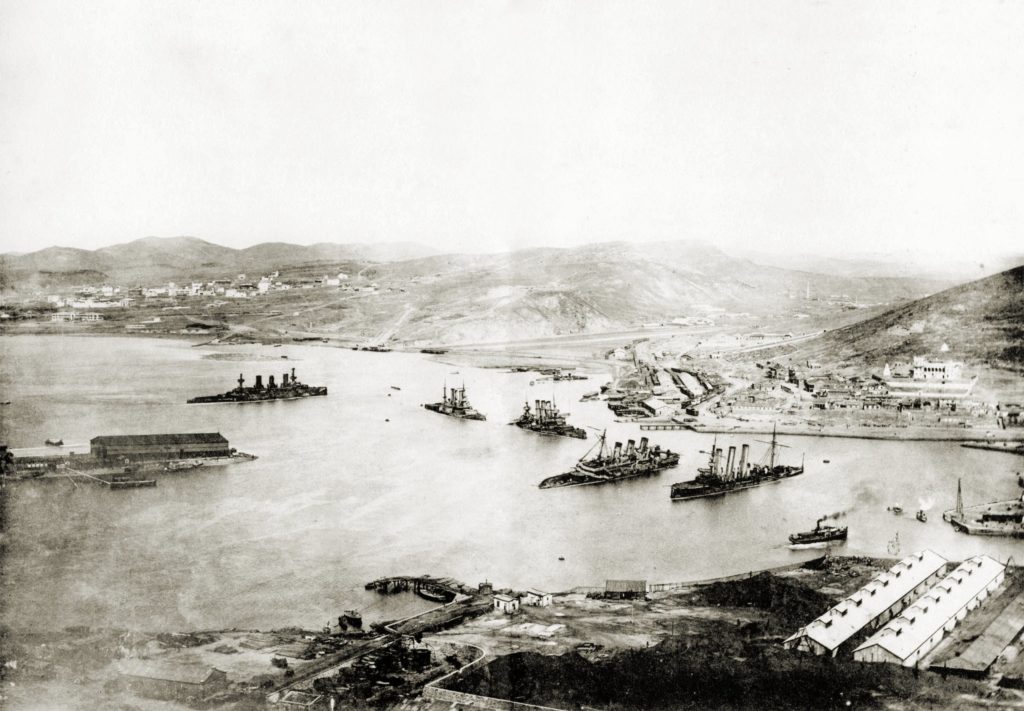
Port Arthur and the Russian Imperial Pacific fleet seen from Gold Hill
Background Development
Tsar Nicholas II emitted the desire of a warm-water port in the Pacific from 1894. In March 1898 Russia signed a 25-year lease for Port Arthur with China as a treaty result of the war of 1894 (Battle of Yalu).
Indeed the Triple Intervention of France, Russia, and Germany forced Japan to return the port and obtain an indemnity by the Chinese instead. Both Japan and Russia lanched extensive shipbuilding programmes, and Russia started from scratch a pacific fleet, in which the Borodino-class battleships would be instrumental.
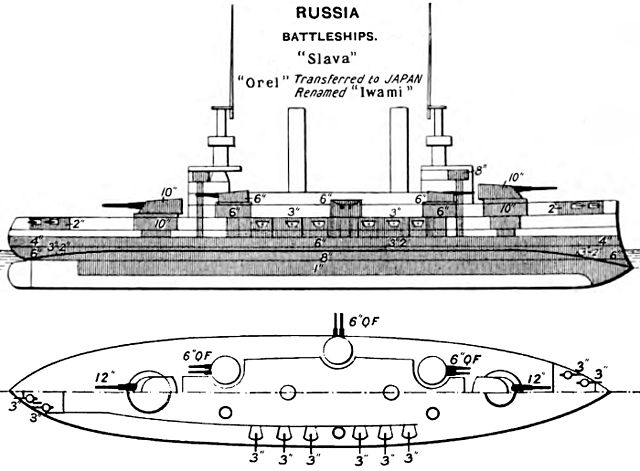
The Borodino class was exceptional at more than one title: Not only it was the most numerous class ever built by Russia, but they were based on the French-designed Tsesarevich to gain time. However new requirements in the designs imposed more speed and a bigger armament, when the contracts were signed.
This, in turn, dictated ships normally with the same speed, draft, guns and armor as the Tsesarevich on a greater displacement. The final design was to be done by D. V. Skvortsov with his tram of the Naval Technical Committee (NTC). It was done in July/August 1898, one month was the contract was signed, showing an increase of 1,000 long tons (1,000 t) in displacement while being slightly larger and wider.

The final appearance of the ships mirrored the Tsesarevich, but Skvortsov squeezed two more casemates for 3.0 in (75 mm) guns, at the bow stern. They were added the twelved 3-in guns on the sides, in the characteristic tumblehome, which was flattened. The centreline bulkhead between the engine and boiler rooms combined to a narrow belt armor presented a risk of submersion.
Design of the Borodino class
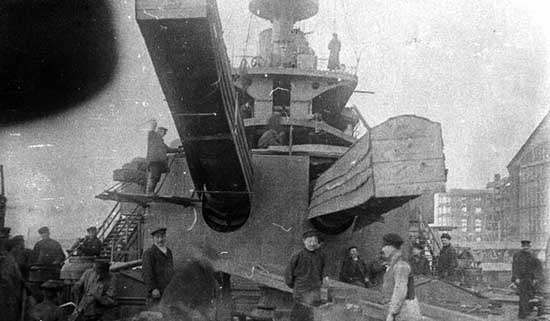
Orjol under construction
The ship’s hull was 389 feet 5 inches long or 118.7 meters waterline, 397 feet 3 inches or 121.1 meters overall. The beam was 76 feet 1 inch or 23.2 m, but the decks width was reduced as for the tumblehome. These battleships had a draft of 29 feet 2 inches or 8.9 meters, when measured completed in battle order, some 38 inches or 0,965 meters more than designed.
This had consequences on the belt armour being lower and possible flooding issues. Normal displacement ranged from 14,091 to 14,145 long tons, 14,317 to 14,372 tonnes. This was some 900 long tons more than designed specifications, originally to be 13,516 long tons. Normal peacetime crew comprised 28 officers and 754 enlisted sailors, up to 928 crewmen in wartime, such as in 1904.
Powerplant of the Borodino-class
The Borodino-class battleships had two four-cylinder triple-expansion steam engines. They each drove their own propeller shaft and were fed by steam coming from 20 Belleville boilers. As designed, top speed was 18 knots (33 km/h; 21 mph) which was good for the time of their conception. Borodino was given a freshly reverse-engineered and copied La Seyne steam engine, previously used on Tsesarvich at the Franco-Russian Works, and transferred at New Admiralty NyD, Saint-Petersburg.
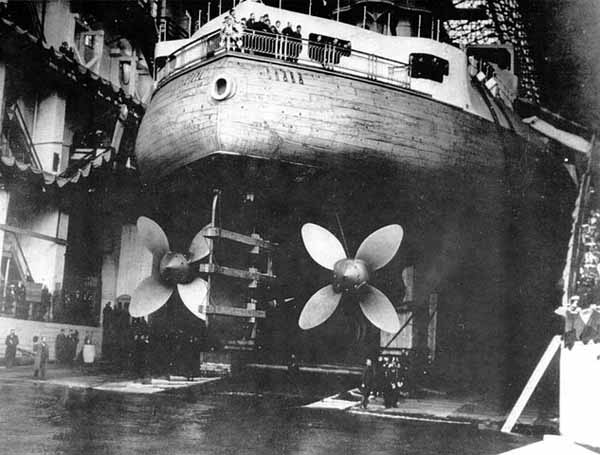
Stern view of Slava before launch, 4-bladed propellers.
The other four ships had Baltic Works machinery. The lead ships VTE engines were rated for 16,300 indicated horsepower (12,200 kW), boilers having a working pressure of 19 atm (1,925 kPa; 20 kgf/cm2). The four other sister-ships developed 15,800 ihp (11,800 kW) at a greater working pressure of 21 atm (2,128 kPa; 22 kgf/cm2). Borodino also had boilers economisers and specific three-bladed screws. Her sister-ships had four-bladed propellers and standard boilers. In addition all had an electrical power station fed by the steam engines, six generators for a total of 738 kilowatts, equivalent to 990 hp.
When completed the ships were to be rushed in the far east. They nevertheless conducted short, botched sea trials. Oryol was the only ship to reach her designed speed, obtained at 14,176 ihp (10,571 kW). The paradox was her sister-ships with forced heating produced a better output but failed to reach 18 knots. They all carried a coal supply of 1,350 long tons (1,372 t). This was enough for 2,590 nautical miles (4,800 km; 2,980 mi) at 10 knots cruising speed. Of course, this meant the ships had to stop in many places or find ways to gather coal during their long world’s round trip to Port Arthur.
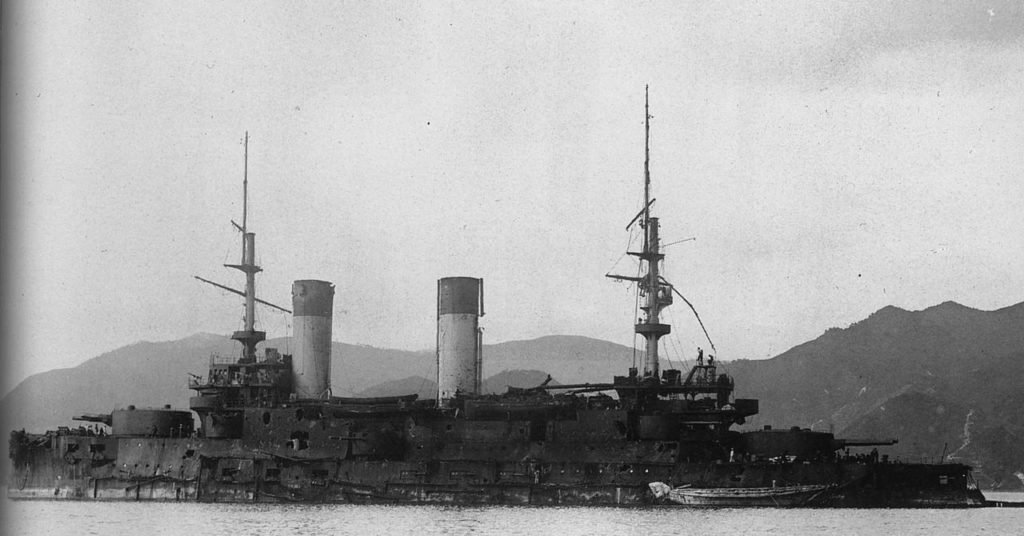
Armament
Main armament:
Two twin 12-inch guns turrets of 4 calibers for and aft. They were mounted the French way on pivot barbettes and with cylindrical, not sloped armour, and run on electric power. Maximum elevation was +15°, and each gun was provided with 60 rounds, 120 for a turret and 240 total. These were 731-pound (332 kg) AP cap shells fired at a muzzle velocity of 2,598 ft/s (792 m/s). Range was 16,010 yards (14,640 m) at maximum elevation, and the rate of fire was 90–132 seconds between each volley (2.2 minutes), which was relatively slow (at least in 1905).
Secondary armament
Twelve 45-caliber Canet Model 1891 6-inch (152 mm) (QF) guns from France were mounted in six twin-gun turrets on the upper deck. They were all electrically-driven, and the mounts allowed a maximum elevation of +15° while their traverse was around 180°, broadside, front and rear. Each gun was supplied 180 rounds, so 2160 in all. They compensated the slow RPM of their main guns, by being able to deliver 2–4 rpm. Thy fired a 91 lb (41.4 kg) shell at a muzzle velocity of 2,600 ft/s (792.5 m/s) and maximum range og 12,600 yards (11,500 m). This means to take advantage of them peppering enemy superstructures of an enemy vessels between main guns volleys obliged to recede about 4000 yards of distance, and more, as 12,000 yards was not optimal. Distances were closer at Tsushima.
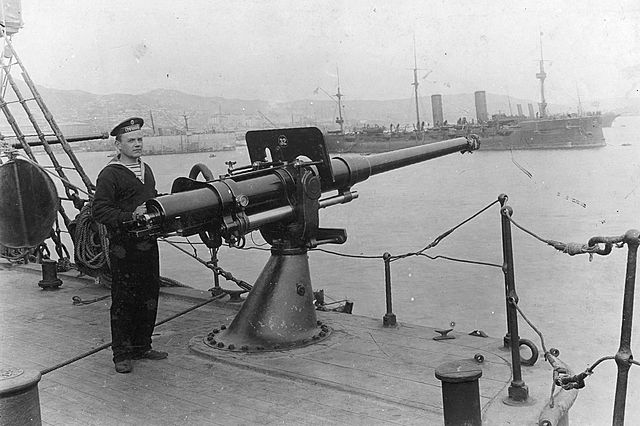
Russian 75 mm gun.
Tertiary Artillery
For close defence against torpedo boats, twenty Canet QF 75 mm/3 in 50 cal. guns were carried, all mounted in hull embrasures. 300 shells were provided for each gun, for a grand total of 6,000 11-pound (4.9 kg) AP shell. They exited the barrel at a muzzle velocity of 2,700 ft/s (820 m/s). Maximal range was 7,005 yards (6,405 m) at +13°. Again it was well above the optimal range (best accuracy ratio). This was not all, as the ships had no less than sixteen to eighteen 47 mm (1.9 in) Hotchkiss guns placed higher in the superstructure, firing each 2.2-pound (1.00 kg) shell at 1,400 ft/s (430 m/s). Their rate of fire was 15 rpm on average. They were the last line of defence against TBs.
Torpedo armament
As customary of the time, the Borodino class carried four 381 mm or 15 in caliber torpedo tubes. Two were mounted above water (bow and stern) and two broadside underwater. The latter were placed close to the forward 12-in magazine. They were ten reloads. This deigned a typically French cross pattern, allowing to fire them in any direction. The Borodino class also has been designed to carrying 50 mines, only to protect their anchorage in little protected areas from Torpedo Boats, in addition to nets.
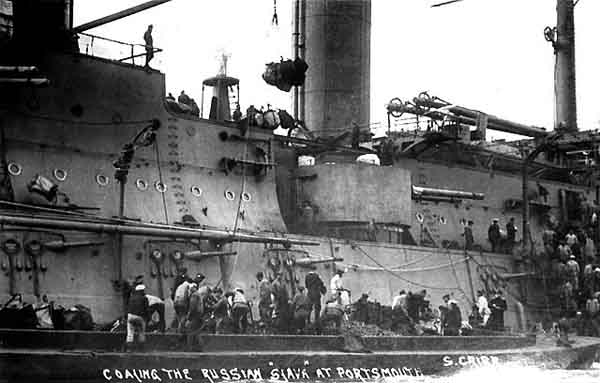
Detail of the flank, Slava coaling in Portsmouth
Rangefinders and fire control
The Borodino class were designed to carry Liuzhol stadiametric rangefinders. They used the angle between two vertical points, aiming for example at the waterline and crow’s nest, in order to estimate the range. These references were passed on to the gunnery officer, which calculated the proper elevation and deflection, data transmitted to each turret officer via a Geisler electro-mechanical fire-control transmission system. However as the ships were fitted-out, they were replaced two Barr and Stroud coincidence rangefinders. The latter used two images to be superimposed to derive the range a more reliable and way faster system.
Also at the last minute, the turrets were fitted with Perepelkin telescopic sights. However the crews never had the time to familiarize with them. For the anecdote, when the ships coal-supplied in Madagascar, a firing exercise took place, revealing the officers used these telemeters quite incorrectly. On the same target, one gave an estimated range of 7,300 meters and the other 11,000 ! Nothing was done to remedy to this settings problem (Journal of the United States Artillery, Volume 30).
The crews were also unfamiliar with the Barr & Stoud system, despite them being easier to learn. It was crucial during the battle as the Japanese ships, built in UK or on British plans were all provided Barr & Stoud rangefinder and the crews were perfectly trained to used them in the British Fashion, claiming the highest accuracy in the world.
Armour protection of the Borodino class battleships
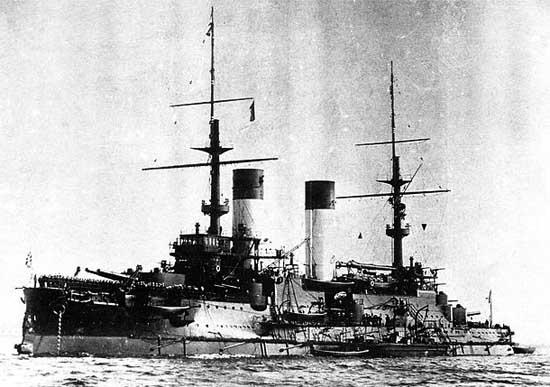
Knyaz Suvorov in Kronstadt 1904
The armour protection scheme was closely derived from the Tsesarevitch, using Krupp cemented (KC) armor. The waterline belt was 5.7–7.64 inches (145–194 mm) thick depending on the location. As usual, thinner beyond barbettes level. The main turrets had 10 in (254 mm) walls with 4 in roofs (100 mm). The secondary turrets were 6-in thick (152 mm) and the 11-pdr (3-in guns) battery deck had equivalent walls of 3-in (76 mm).
The deck armor was only 1 to 2 inches (25 to 51 mm) on two levels and the armored deck, lower, was 1.5-inch (38 mm) thick, and curved downwards to create an anti-torpedo bulkhead. The conning tower had 8-in (203 mm) walls. These figures ate not particularly impressive, the same as on the Tesarevich, but even weaker as the latter has her Conning tower protected by 10-in walls.
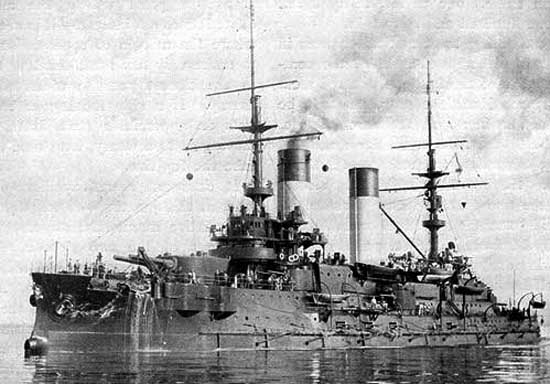
Oryol (Orel), date unknown
Slava (1901) specifications |
|
| Dimensions | 121 x 23.22 x 7.97m (397 ft x 76 ft 2 in x 26 ft 2 in) |
| Displacement | 13,517 long tons (12,900 t) standard, 15,000 FL ? |
| Crew | 835 – 995 |
| Propulsion | 2 shafts VTE engines 4 Cyl. 20 boilers, 16,300 ihp |
| Speed | 18 knots (33 km/h; 21 mph, as designed) |
| Range | 5,500 nmi (10,200 km; 6,300 mi) at 10 knots |
| Armament | 4 x 305mm/40 (12-in, 2×2), 12 x 152mm/45 (6-in, 6×2), 12 x 75mm/50 (3-in), 20 x 47mm/50 (3-pdr), 4 x 356 mm TTs (15 in, 2 surf, 2 sub, 10 reloads), 40 mines |
| Armor | Waterline belt: 160–250 mm (6.3–9.8 in), Decks: 40–50 mm (1.6–2.0 in), Turrets, barbettes: 250 mm (9.8 in), CT: 10 in (254 mm) |
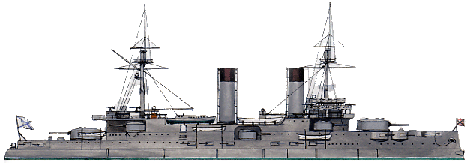
Profile of the Slava by the author in 1914
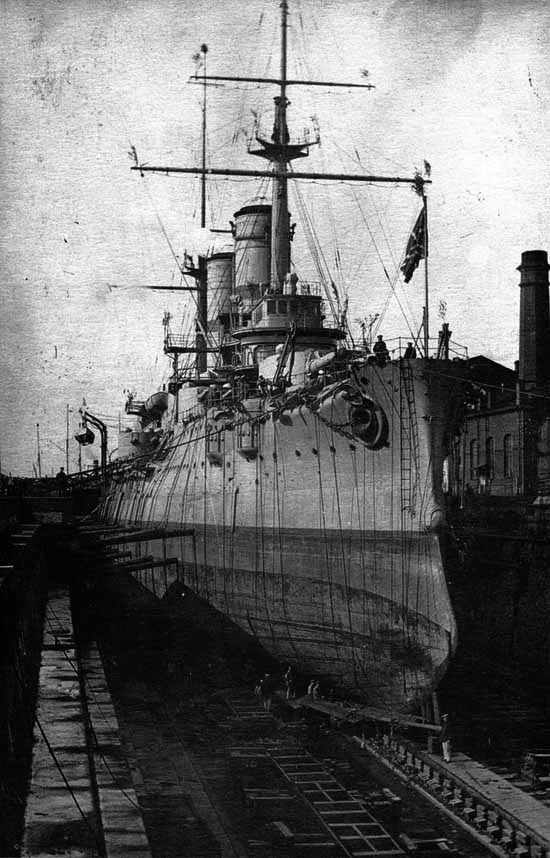
Slava in drydock during WW1; This battleship had an active carrer in the baltic, duelling with four German battleships in all, including two dreadnoughts.
Sources
Conway’s all the world’ fighting ships 1860-1905
Arbuzov, Vladimir V. (1993). Borodino Class Armored Ships. Armored Ships of the World. 1.
Campbell, N.J.M. (1978). “The Battle of Tsu-Shima, Parts 1, 2, 3, and 4”. Antony Preston
Forczyk, Robert (2009). Russian Battleship vs Japanese Battleship, Yellow Sea 1904–05.
Hough, Richard (1958). The Fleet That Had To Die.
Jentschura, Hansgeorg; Jung, Dieter & Mickel, Peter (1977). Warships of the Imperial Japanese Navy, 1869–1945.
McLaughlin, Stephen (2003). Russian & Soviet Battleships.
Nekrasov, George M. (2004). Expendable Glory: A Russian Battleship in the Baltic, 1915–1917.
Pleshakov, Constantine (2002). The Tsar’s Last Armada: The Epic Voyage to the Battle of Tsushima.
Preston, Antony (1972). Battleships of World War I: An Illustrated Encyclopedia of the Battleships of All Nations 1914–1918.
Preston, Antony (2002). The World’s Worst Warships. London: Conway Maritime Press.
Silverstone, Paul H. (1984). Directory of the World’s Capital Ships.
Staff, Gary (2008). Battle for the Baltic Islands 1917: Triumph of the Imperial German Navy
Westwood, J. N. (1986). Russia Against Japan, 1904–1905: A New Look at the Russo-Japanese War.
//ja.wikipedia.org/wiki/%E3%82%B9%E3%83%A9%E3%83%B4%E3%82%A1_(%E6%88%A6%E8%89%A6) More photos
//en.wikipedia.org/wiki/Borodino-class_battleship
//weaponsandwarfare.com/2015/11/18/borodino-class/
//www.wrecksite.eu/wreck.aspx?135669
Extra photos – web archives
Journal of US artillery, vol.30
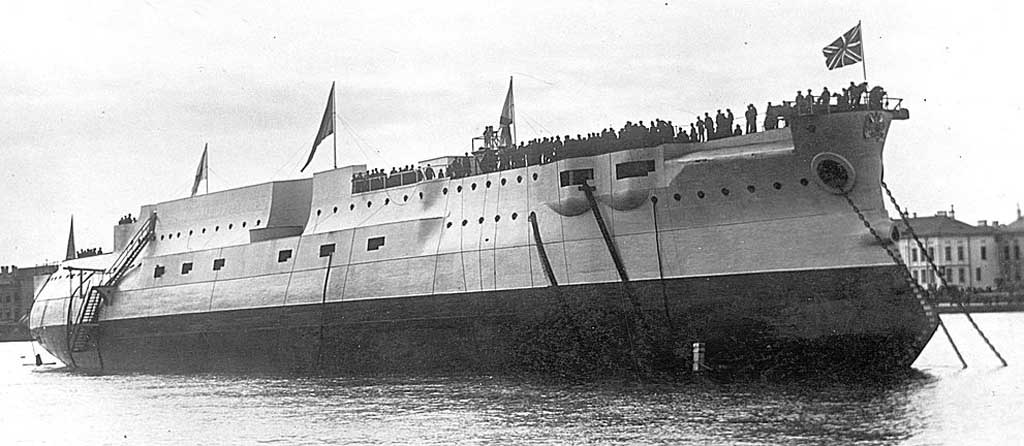
Launch of the Borodino in St Petersburg
Model Kits:
-Zvezda 500789027 Model Cruiser Borodino 1:350
-Kniaz Suvorov 1/750 Eastern Express Kit review
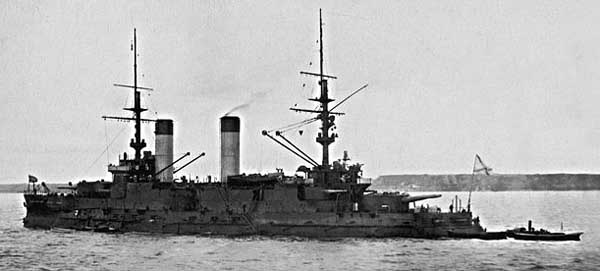
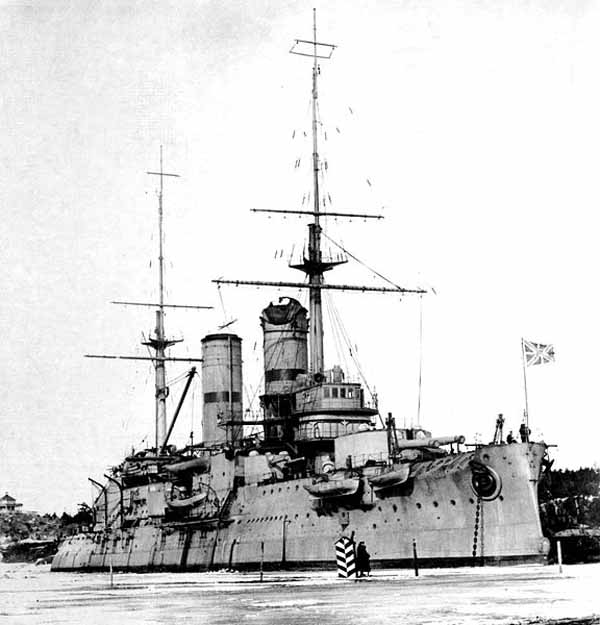
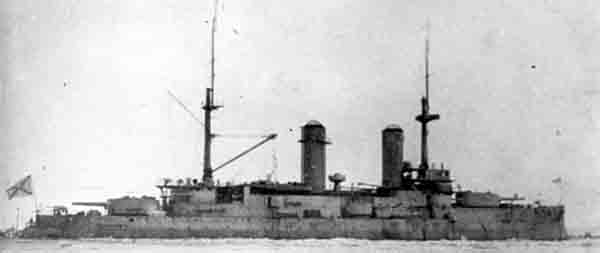
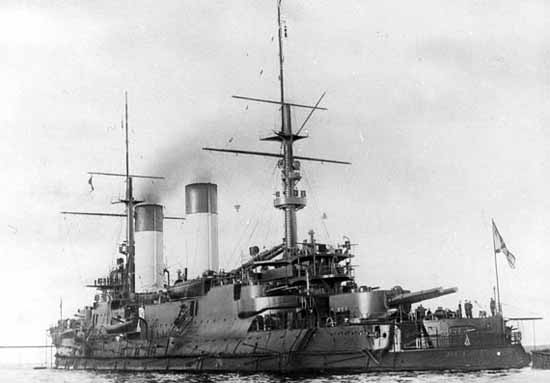
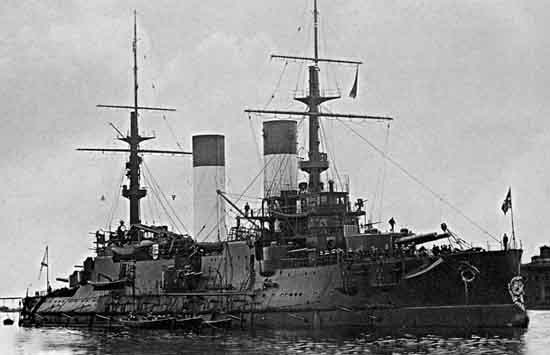
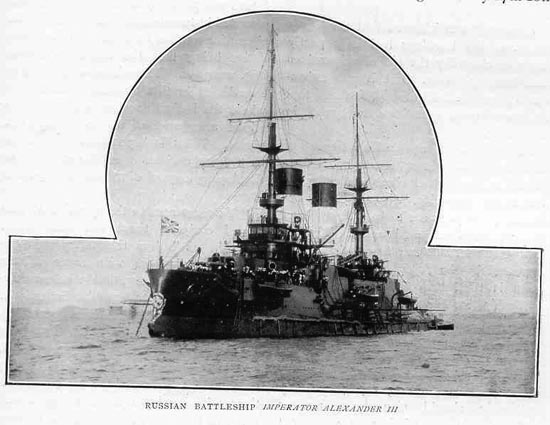
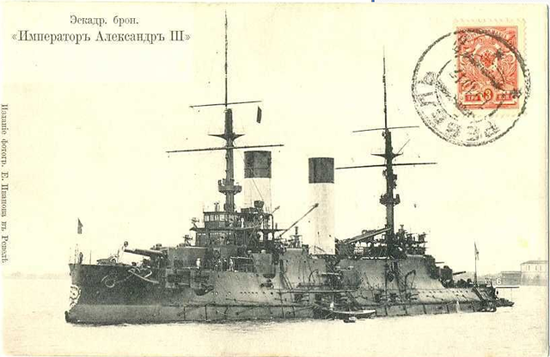
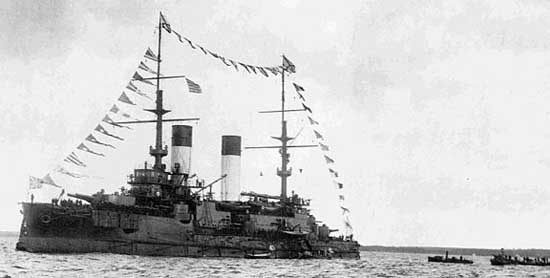
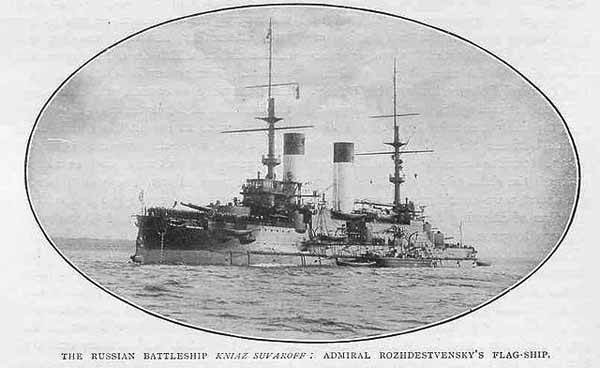
The Borodino class in action
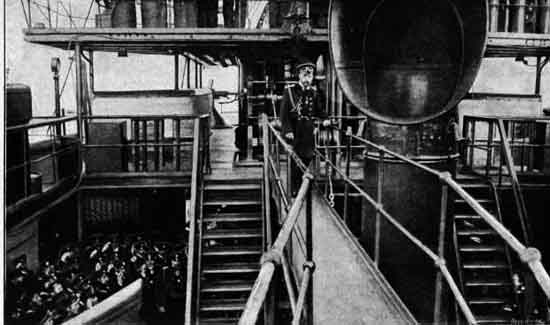
Speech of the Tsar Nicholas II onboard Knyaz Suvorov before departure
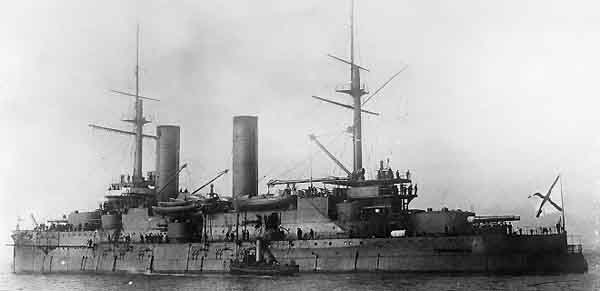
Slava, aft view in 1915
The completion of the Borodino class ships started with Imperator Aleksander III in November 1903, followed by Borodino in August 1904, Knyaz Suvorov in September 1904, Oryol in October 1904, and Slava in October 1905, the only one that missed the battle of Tsushima. The Russo-Japanese war broke out in February 1904, so only Imperator Aleksander III was ready by that time, with a brand new crew which tried to familiarize with the ships.
On 15 October 1904, Knyaz Suvorov, flagship of Vice Admiral Zinovy Rozhestvensky, commander of the 2nd Pacific Squadron. He took the lead of the three other sister ships and departed for Port Arthur. The first step was Libau to gather the squadron and supplies. Alrter came that torpedo boats disguised as fishing vessels were present on the intended course and maximal alert was kept.
Diplomatic incident
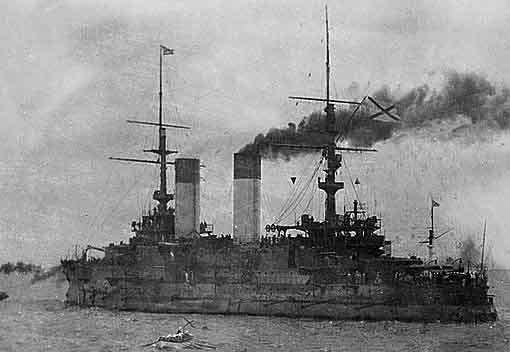
Oryol under tow, circa 1905
Coaling was done at Skagen in Denmark on 7 October and the following day, at the early hours near the Dogger Bank, an auxiliary repair ship, Kamchatka made an alarmist reported of an attack by torpedo boats in the rainy mist. Four hours later, the squadron stumbled upon fishing trawlers on the Dogger Bank.
Due to the previous warning and recent alert, and after a quick deliberation, Rozhestvensky signalled to the fleet to open fire, at very short range. The mist somewhat prevented a correct identification, and the strike was merely preventive. But it had grave consequences: One trawler was sunk, three others badly damaged; Fishermen were killed and wounded. In the mist, confusion was such that the battleships at some point also misidentified the Aurora and Dmitrii Donskoi and fired on them, before a warning was sent by projector.
After returning to port, the surviving trawlers reported the incident, which spread like wildfire. This enraged the British population and caused a diplomatic incident. The parliament was nearly bordering war. At that time, France and Russian had a strong alliance, from which the British were excluded, and there has been tensions already in the far east over Russian imperialist ambitions.
There was even in the 1890s a “cruiser scare” which conducted the Royal Navy to launch the construction of two massive armoured cruisers, the Powerful and Terrible. In the end, there were quick telegraphic exchanged from Moscow and official apologies by the ambassador. Russia in the end agreed to pay reparations on 29 October and the incident was closed.
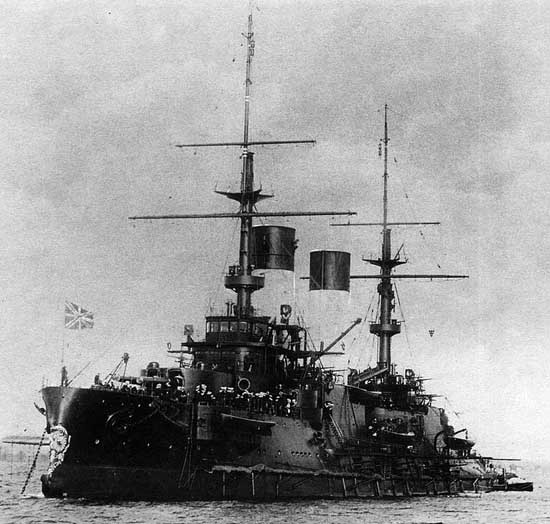
Imperator Aleksander III in 1904 in Kronstadt
Stop at Madagascar
Rozhestvensky, meanwhile, informed of the incident, nevertheless condicted his fleet down the Atlantic, in view of the African coast. He arrived at the Cape of Good Hope and reached the island of Nosy Be, off the north-west coast of Madagascar by 9 January 1905. Madagascar was then French and due to the alliance, granted hosting to the Russian fleet for two months. This allowed the fleet to coal, other supplied to be taken on board, and the crews to train.
Meawnhile a telegram arrived to the Admiral HQ, and he learned of the capture of Port Arthur. After a reunion with all officers, he decided to aim to Vladivostok instead, to hous the pacific fleet. This was indeed the second only Russian port in the area. Therefore the squadron departed again for Camranh Bay in French Indochina on 16 March.
Stop in Indochina and departure for Vladivostock
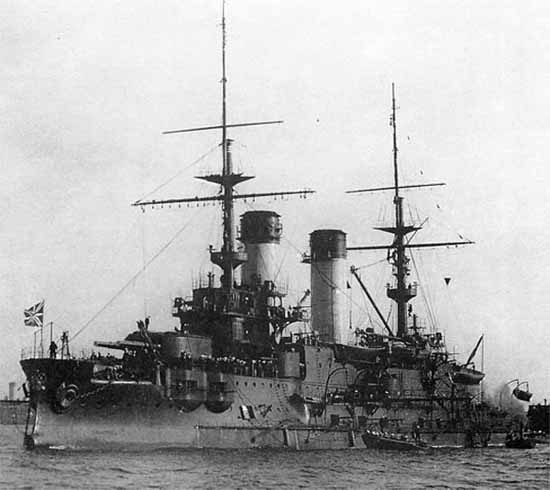
Borodino in Kronstadt, 1904
The squadron reached the bay a month later and stayed there. The goal was to wait after the older ships of the 3rd Pacific Squadron (Rear Admiral Nikolai Nebogatov). They arrived at Camranh Bay on 9 May. The combined fleet then departed for Vladivostok on 14 May. The ships by then had been supplied again with massive quantitied of coal for the long trip north, perhaps as much as 1,700 long tons or beyond, stored high on the decks, which hampered their stability and submerged their waterline armor belt.
This had grave consequences as the shops were already known to have overweight problems with the submersion of the belt. It was now further down below of 4 feet 6 inches (1.4 m) with consequences such as possible massive and quick flooding if the ships were hit above, which was very likely.
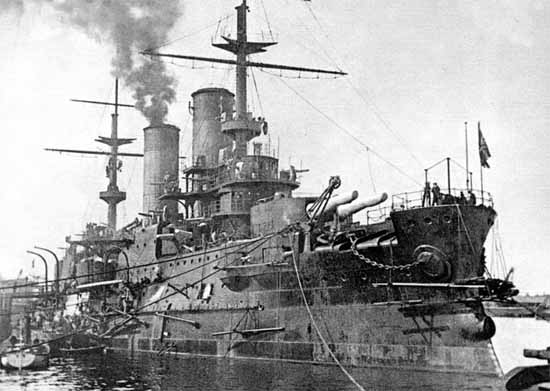
Same as above. The black livery was relatively unusual when made for the hole superstructures in addition to the hull, but the tumblehome imposed this. Funnels were yellow. No attempt to paint them in grey were made during their trip.
The battle of Tsuhima
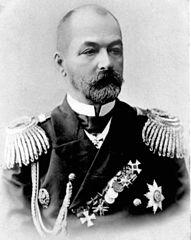 Before the battle, Rozhestvensky grouped the four Borodinos into one division, and commanded it. Oryol, trailing at the rear of the column, fired the first shots of the Battle after Nikolay Yung her captain spotted a Japanese cruiser at 11:42 at around 9,000 meters (9,800 yd). Rozhestvensky ordered Yung to cease fire, as the latter had little success. Knyaz Suvorov in the lead opened fire at the IJN Mikasa (Admiral Tōgō Heihachirō’s flasghip) at 14:05. The Japanese line then opened fore in turn; Soon, superior marksmanship and rate for fire took their toll on the Russians: Their HE shells set fire in the superstructures of the Borodinos class battleships and at 14:35, both Rozhestvensky and the captain were wounded by splinters entering through the conning tower’s thin openings. At 14:52 Knyaz Suvorov’s steering gear was hit as she manoeuvered to starboard and she was condemned to make full circles until engineered can use her machines to compensate. Her aft gun turret was destroyed by an explosion and her quarterdeck devastated, forward funnel obliterated, mainmast shot away while the thick smoke of the burning superstructures were obscuring the gunner’s spotters view completely.
Before the battle, Rozhestvensky grouped the four Borodinos into one division, and commanded it. Oryol, trailing at the rear of the column, fired the first shots of the Battle after Nikolay Yung her captain spotted a Japanese cruiser at 11:42 at around 9,000 meters (9,800 yd). Rozhestvensky ordered Yung to cease fire, as the latter had little success. Knyaz Suvorov in the lead opened fire at the IJN Mikasa (Admiral Tōgō Heihachirō’s flasghip) at 14:05. The Japanese line then opened fore in turn; Soon, superior marksmanship and rate for fire took their toll on the Russians: Their HE shells set fire in the superstructures of the Borodinos class battleships and at 14:35, both Rozhestvensky and the captain were wounded by splinters entering through the conning tower’s thin openings. At 14:52 Knyaz Suvorov’s steering gear was hit as she manoeuvered to starboard and she was condemned to make full circles until engineered can use her machines to compensate. Her aft gun turret was destroyed by an explosion and her quarterdeck devastated, forward funnel obliterated, mainmast shot away while the thick smoke of the burning superstructures were obscuring the gunner’s spotters view completely.

Borodino, aft view
Imperator Aleksandr III followed Knyaz Suvorov until she was out of contro, and turned north to try to manoeuvrer around the IJN battleline. While Knyaz Suvorov concentrated Japanese fire, Imperator Alexandr III’s captain Nikolai Bukhvostov, tried to emulate Retvizan’s maneuver at the Battle of the Yellow Sea, brashly charging straight to change their focus away from Knyaz Suvorov. This succeeded but to a high price, as the ship was crippled in turn. Borodino then, relatively spared, took the lead and other the ships to turn south trying to disengage and take refuge in the mist and fog.

Imperator Aleksander III in Reval, 1904
Knyaz Suvorov was found isolated, and the Russian destroyer Buinyi started to evacuated the admiral and other officers. But the ship was still capable of fighting and resumed the fight: With just an unwounded midshipman in command, she veered southwards and continue her course at about 4–5 knots. Soon, Japanese cruisers engaged her from 18:30 until there was so much smoke and fire that her gunners fired at random. Four Japanese torpedo boats of the 11th Torpedo Division then closed in and attacked at 19:20. Seven torpedoes were fired, two-three hitted the hull, possibly detonating a magazine as a spotters swa a huge cloud of yellow and black smoke bellowing out. The battered Knyaz Suvorov listed to port even more and capsizing at about 19:30, taking with her the remainder of the crew, some 928 sailors aboard. Special tribute was paid after the war to their gallantry, and by the officers onboard Buinyi.
The Japanese never lost sight of the Russians and the duel resumed around 18:00. Togo concentrated fire upon Imperator Aleksandr III and Borodino, the only ships spared so far. Imperator Alexandr III was hopelessly devastated and at 18:30 she capsized, and sink around 19:07, sadly with no survivors. Borodino was also wrecked but resisted better. She even succeeded hitting the battleship Shikishima at 19:18, soon engulfed in flames, and the ships destroyed each others turrets. Ten minutes later the Japanese ceased fire and the last hit from IJN Fuji hit Borodino beneath her starboard forward six-inch turret. The flash was communicated to the ready-use ammunition in the turret. The following detonation came as a shock for all that were present. Several magazines exploded in turn, opening a huge gash into her hull, and she quickly capsized and sank. Only one crewman was saved (from 855) projected away from the ship when she exploded.
Oryol was the last of the four Borodino class still in shape of doing some action, and took the lead in turn, soon was joined by Nebogatov’s Second Division. Meanwhile, the IJN fleet disengaged with darkness falling. Nebogatov took command of the crippled fleet and proceeded to Vladivostok. However the Japanese were waiting for them, and at around 10:00, they fell on Nebogatov and attacked the fleet.

Imperator Aleksander III postcard
Since they were faster, the Japanese ships stayed beyond the range of the Russian ships, and the admiral, after a few shots, understood his fate was sealed, as he has no hope of winning. He decided to surrender at 10:30. This was one of the few events that showed that longer artillery range and speed could wing a victory almost without firing a shot. A lesson well understood by all naval staff around the world, notably admiral Fisher, confirmed on his ideas of a monocaliber fast battleships and battlecruisers.
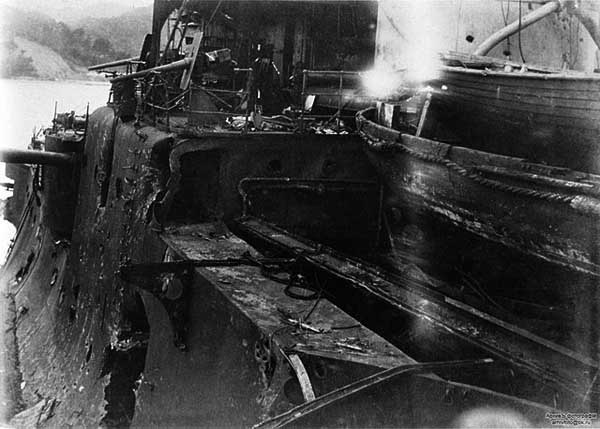
Orel damaged during the battle
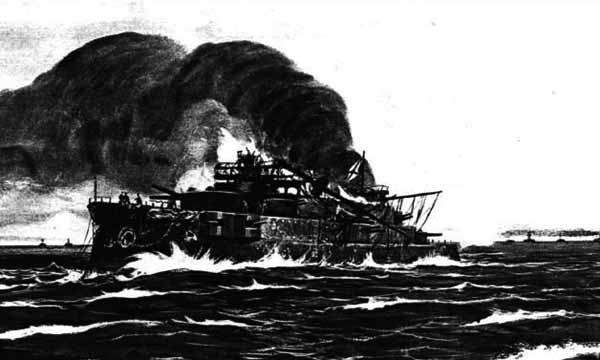
Suvorov battle damage
The capture or Oryol and new career as IJN Iwami
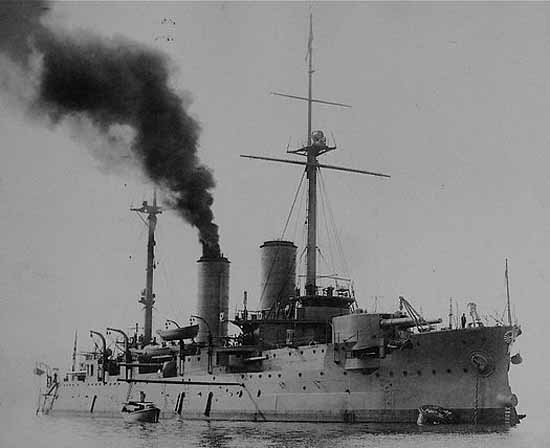
IJN Iwami after reconstruction in Kure, 1907
The Japanese captured Oryol, which was towed in Japan for repairs and reconstruction before she was recommissioned n June 1907 as IJN Iwami. A dedicated post will be done on her but here are the details: The Japanese engineers knew her main problem was her top weight, and they cut down the superstructure while the were repositioned lower. Also her original worn-out boilers were replaced by more modern Miyabara boilers. At last, for supplies reasons, she was entirely rearmed her with Japanese guns. Her displacement fell to 13,500 long tons (13,700 t) while the crew was about 750 officers and sailors.
As such, Iwami served in WW1, participating in the Siege of Tsingtao in 1914, and served as flagship of the Japanese expeditionary force in Vladivostok in 1918 (Russian Civil War). She was then a training ship in 1921 and was disarmed in 1922 (Washington Naval Treaty)later sunk as target or BU in Kobe in 1924.
Slava: The survivor
Slava (Baltic Works, Saint Petersburg), laid down on 1 November 1902, was launched on 29 August 1903 and completed in October 1905 so she missed the Russo-Japanese War. When at home, her first mission of importance was to team up with Tsesarevich, helpeding to suppress the Sveaborg Rebellion (1906). She served as a training ship for new officers (Naval College created with the post-Tsushima naval reforms). When in the Mediterranean, she rescued survivors from the 1908 Messina earthquake, carried to Naples. In August 1910 one of her boilers exploded and was towed by Tsesarevich to Gibraltar for temporary repairs. She want after to Toulon’s drydock for more extensive repairs lasting a year. Back to Kronstadt she was transferred to the Baltic Fleet.
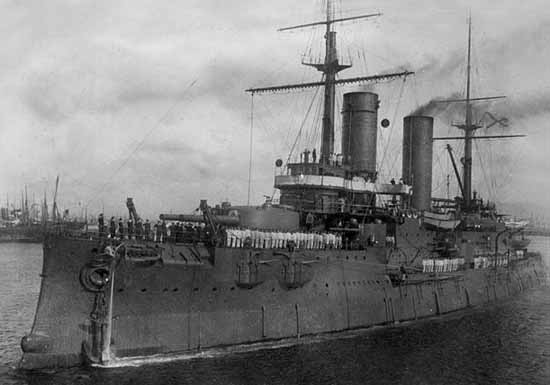
Slava in Piraeus, 1907
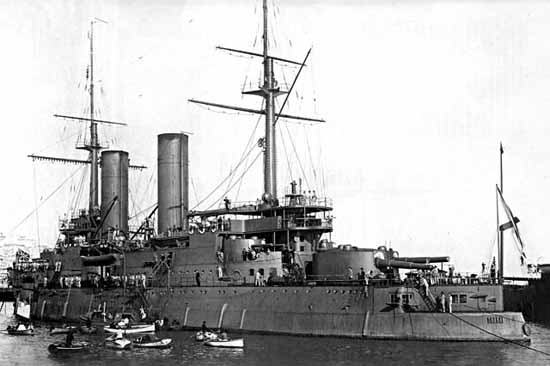
Slava in naples, 1908
In this fleet she was just on of four pre-dreadnoughts known as the Second Brigade when the war broke out, whereas the Gangut class dreadnoughts were in completion. She was sent to patrol the Gulf of Finland, through the Irbe Strait on 31 July 1915 providing gunfire cover for Russian troops around Riga and repel possible German reinforcements.
Duing this mission, on 8 August, Slava was posted at the Irbe Strait, teaming with the gunboats Khrabry and Groziashchii, watching in recently placed minefields. She spotted German minesweepers and engaged them, but soon they were rejoined by the German pre-dreadnoughts Elsass and Braunschweig. Slava duelled with both, stasking massive splinter damage from near misses but her captain did not ordered to anwser back, to not reveal he was out-ranged. The Germans eventually withdrawn, having failed in their mission.
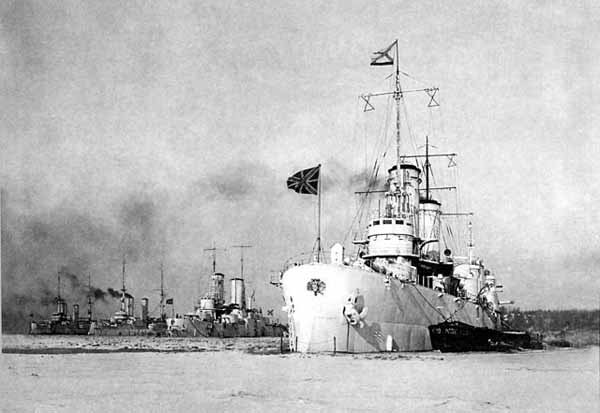
2nd Battleship brigade winter 1914-15 in helsingfors
On 16 August, they came back, this time reinforced by the SMS Nassau and Posen to protect the minesweepers. Slava in shallow waters, had by order of the captain her side compartments flooded, in order to give them the 3° list list which artificially increased her maximum range to 18,000 yards (16,459 m). By doing this, she also raised her belt higher, providing better protection surface of her side. This was reckless as by doing this she hmpered her chances to withdraw.
Yet again, even though she was surrounded by near-misses, she did not engage the Germans, concentrating on the minesweepers and later the armored cruiser Prinz Adalbert which came nearer to open fire. Yet again, the Germans retired, but they came back the following day, and deliberattly, more accurately fired on Slava which was eventually was hit three times (by 28 cm (11.1 in) rounds).

Slava in 1916
Her upper belt armor was penetrated and the heat made coal bunker explode, while the second pierced through the upper deck, and disabled the supporting tube of the aft port side six-inch turret. A fire spread to the ammunition hoist, but the magazine was flooded. The third just pierced through two boats and exploded in the water on the other side. Evetually, Slava received the order to withdraw and pumps were activated to allow her to be fully reloated. The Germans entered the Gulf of Riga on the 19, but forced to withdraw after the submarine HMS E1 torpedoed the battlecruiser Moltke while the Russian coastal artillery squared on other ships dangerously.
Slava, meanshile was undergoing repairs and later on resumed her gunfire cover for the troops. On 25 September 1915, was bombarded German positions ner Tukums when German field artillery started to take her as target. She was hit in the conning tower, killing the captain and officers. There were conflicting attribition as Nekrasov reported a German account of a 10-kilogram (22 lb) bomb dropped by German seaplanes. The relatively weak rood was indeed not able to resist the blast. Slava nevertheless performed her mission to the full, until the Gulf of Riga was starting to freeze over. She retired to Kuivastu for the winter. There, German seaplanes went on attacking and she was hit by three other light bombs on 12 April 1916, claiming seven sailors. On 2 July she was back to try to repel advancing German troops. She was engaged by field artillery, taking a 8-inch (203 mm) shell on the waterline. Support went on for the whole summer. Submarine UB-31 tried to ambush her, and low-flying torpedo bombers attacked her when she was busy targeting German cruisers on 12 September as a bait. They all missed but this was important as the first ropedo attack by planes on a moving battleship in history.
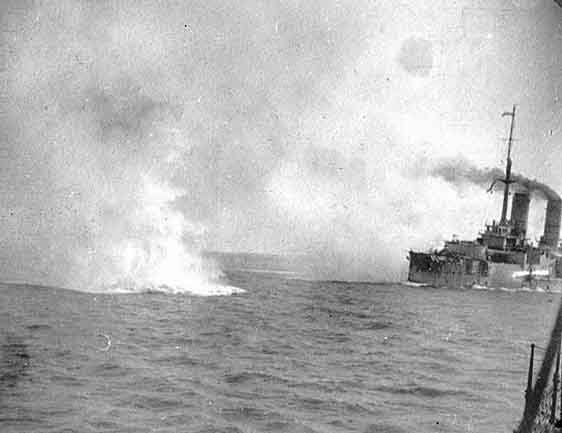
Battle of Moon sund 1917
The last chaper was the Battle of Moon Sound:
In October 1917, Slava was kept in reserve during the German landings on Saaremaa Island, at the mouth of the Gulf of Riga. Slava was defensinf the Kassar Wiek inlet, between Saaremaa and Hiiumaa (or Dagö). She spotted and fire on German torpedo boats on 15-16 October, and went to the Moon Sound Strait.
On 17 October German minesweepers attempted clean up minefield south to the Moon Sound Strait when Slava, Grazhdanin and the cruiser Bayan sailed to their estimated position by Vice Admiral Mikhail Bakhirev. At 8:05 a.m. they engaged the minesweepers, soon spotted and engaged in turn by SMS König and Kronprinz. The Russians splitted their forces, and Slava, further south, engaged the dreadnoughts at long range 12 minutes later while Grazhdanin and Bayan dealt with the minesweepers.
The German concentrated on the Slava, which was the objective, but missed, falling short while Slava resumed to fire, but scoring no hit but closer near-misses, on König in particular. Realizing their position in a narrow swept channel did not authorized any manoeuver, they retired.
Meanwhile, the German minesweepers went on in their mission, as the Russians missed them for the most. They meremy had shell splinters damage and were flooded by near misses; avant when all thee Russian ships reunified and shore batteries opened fire in turn. Slava’s front turret was disabled by accident (probably metal fatigue) and fired 11 shots only before she had to stop. The Russian fleet was ordered north to eat and rest and returned to resume firing at 10:04.
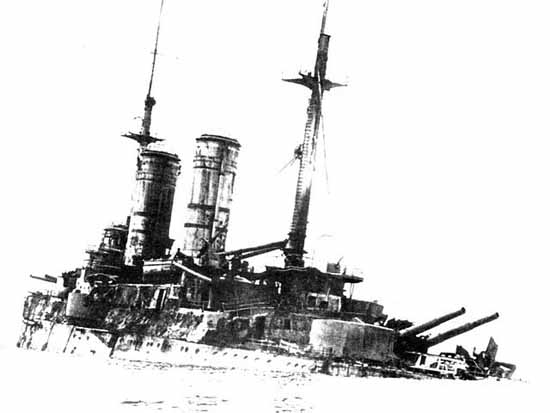
Slava flooded and battle damaged before scuttling at Moon sund
Slava then fired with her rear turret at 12,000 yards (10,973 m), but by then, the minesweepers had cleared a channel northwards, allowing both German deradnughts to return and pass through the minefields, surprising the Russians: SMS König opened fire first on Slava at 10:14. She took three hits: Her bow dynamo room was blasted and flooded. The forward 12-in magazine was also flooded and other compartments damaged, the capstan also disabled.
Taking 1,130 metric tons and a list of 8° compensated by counter-flooding but her forward draft was now 32 feet (9.8 m), in the shallow waters. The third hit hit the port side armor but bounced off. She took two more shits in the superstructure, blewing the ix-inch magazine and forward boiler room but the fire was mastered and the forward left 6-in magazine was flooded. At 10:39 she took two other hits, exploding in the boiler room. By then she was ordered to retire northwards, Bayan trying to make a diversion.
The drama was however that Slava’s bottom was in contact with the gound below. Even with the machines at full power, she did not moved, trapped between Hiiumaa Island and Vormsi Island. She was to wait for deep-draft ships entering the channel to scuttle herself at the entrance. However she was grounded on a shoal southeast of the channel instead by the revolutionary sailor’s committed. Later destroyers evacuated the crew. Her 12-in magazine was detonated and three destroyers torpedoed her. She was struck on 29 May 1918, scrapped in 1935 by the Estonians.

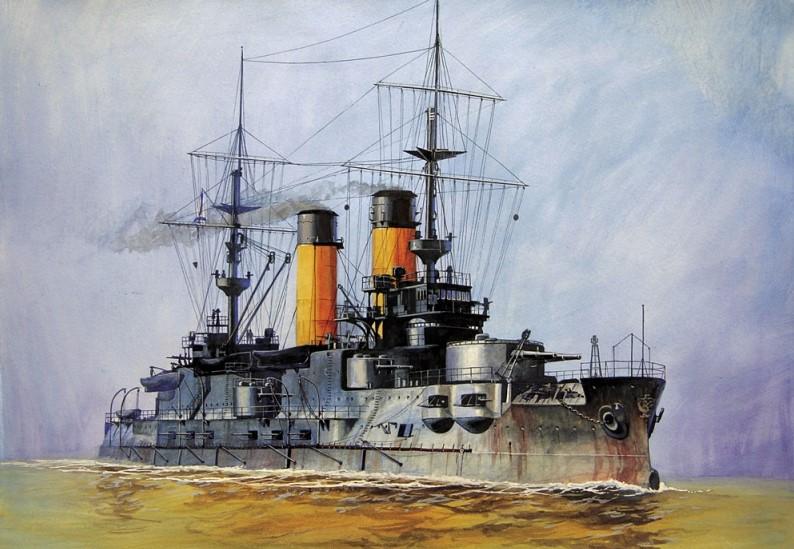
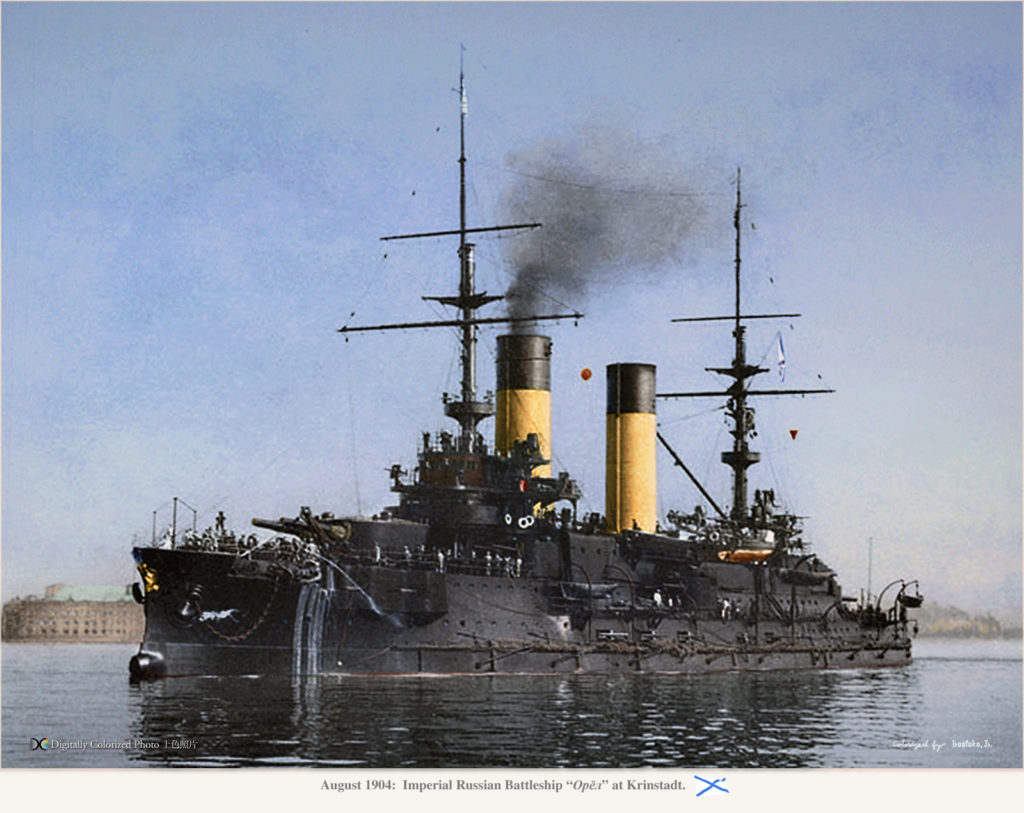
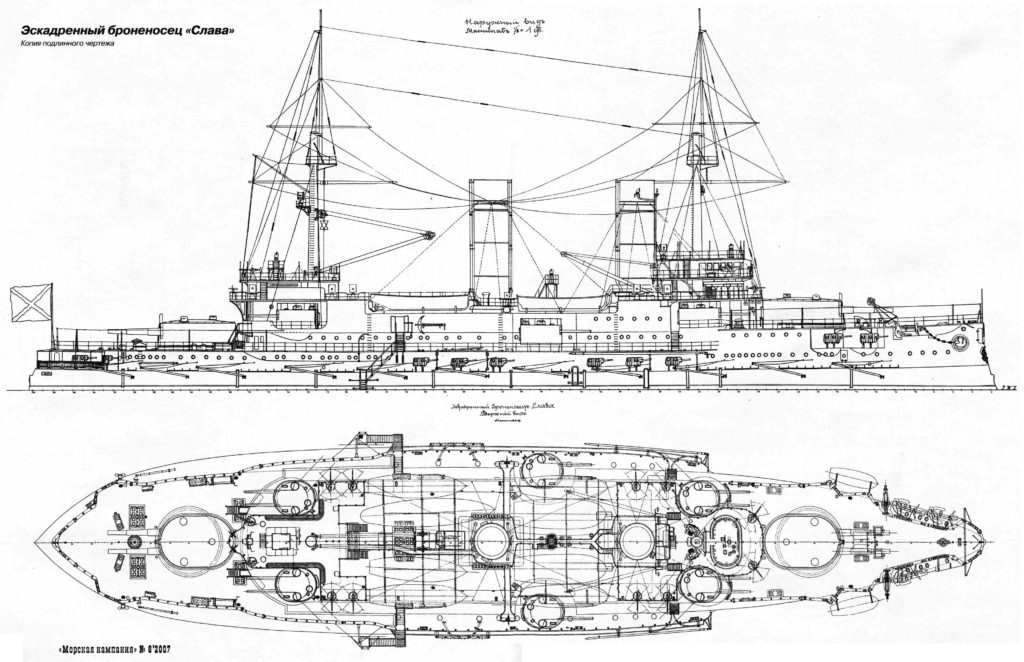
 Latest Facebook Entry -
Latest Facebook Entry -  X(Tweeter) Naval Encyclopedia's deck archive
X(Tweeter) Naval Encyclopedia's deck archive Instagram (@navalencyc)
Instagram (@navalencyc)





 French Navy
French Navy Royal Navy
Royal Navy Russian Navy
Russian Navy Armada Espanola
Armada Espanola Austrian Navy
Austrian Navy K.u.K. Kriegsmarine
K.u.K. Kriegsmarine Dansk Marine
Dansk Marine Nautiko Hellenon
Nautiko Hellenon Koninklije Marine 1870
Koninklije Marine 1870 Marinha do Brasil
Marinha do Brasil Osmanlı Donanması
Osmanlı Donanması Marina Do Peru
Marina Do Peru Marinha do Portugal
Marinha do Portugal Regia Marina 1870
Regia Marina 1870 Nihhon Kaigun 1870
Nihhon Kaigun 1870 Preußische Marine 1870
Preußische Marine 1870 Russkiy Flot 1870
Russkiy Flot 1870 Svenska marinen
Svenska marinen Søværnet
Søværnet Union Navy
Union Navy Confederate Navy
Confederate Navy Armada de Argentina
Armada de Argentina Imperial Chinese Navy
Imperial Chinese Navy Marinha do Portugal
Marinha do Portugal Mexico
Mexico Kaiserliche Marine
Kaiserliche Marine 1898 US Navy
1898 US Navy Sovietskiy Flot
Sovietskiy Flot Royal Canadian Navy
Royal Canadian Navy Royal Australian Navy
Royal Australian Navy RNZN Fleet
RNZN Fleet Chinese Navy 1937
Chinese Navy 1937 Kriegsmarine
Kriegsmarine Chilean Navy
Chilean Navy Danish Navy
Danish Navy Finnish Navy
Finnish Navy Hellenic Navy
Hellenic Navy Polish Navy
Polish Navy Romanian Navy
Romanian Navy Turkish Navy
Turkish Navy Royal Yugoslav Navy
Royal Yugoslav Navy Royal Thai Navy
Royal Thai Navy Minor Navies
Minor Navies Albania
Albania Austria
Austria Belgium
Belgium Columbia
Columbia Costa Rica
Costa Rica Cuba
Cuba Czechoslovakia
Czechoslovakia Dominican Republic
Dominican Republic Haiti
Haiti Hungary
Hungary Honduras
Honduras Estonia
Estonia Iceland
Iceland Eire
Eire Equador
Equador Iran
Iran Iraq
Iraq Latvia
Latvia Liberia
Liberia Lithuania
Lithuania Mandchukuo
Mandchukuo Morocco
Morocco Nicaragua
Nicaragua Persia
Persia San Salvador
San Salvador Sarawak
Sarawak Uruguay
Uruguay Venezuela
Venezuela Zanzibar
Zanzibar Warsaw Pact Navies
Warsaw Pact Navies Bulgaria
Bulgaria Hungary
Hungary

 Bundesmarine
Bundesmarine Dutch Navy
Dutch Navy Hellenic Navy
Hellenic Navy Marina Militare
Marina Militare Yugoslav Navy
Yugoslav Navy Chinese Navy
Chinese Navy Indian Navy
Indian Navy Indonesian Navy
Indonesian Navy JMSDF
JMSDF North Korean Navy
North Korean Navy Pakistani Navy
Pakistani Navy Philippines Navy
Philippines Navy ROKN
ROKN Rep. of Singapore Navy
Rep. of Singapore Navy Taiwanese Navy
Taiwanese Navy IDF Navy
IDF Navy Saudi Navy
Saudi Navy Royal New Zealand Navy
Royal New Zealand Navy Egyptian Navy
Egyptian Navy South African Navy
South African Navy






























 Ukrainian Navy
Ukrainian Navy dbodesign
dbodesign
Four of the five Borodino class battleships were lost in combat – Borodino, Imperator Alexander III, Kniaz Suvorov and Slava, while the fifth member of the class, the Orel, was captured by the Japanese at the Battle of Tsushima in May 1905 –